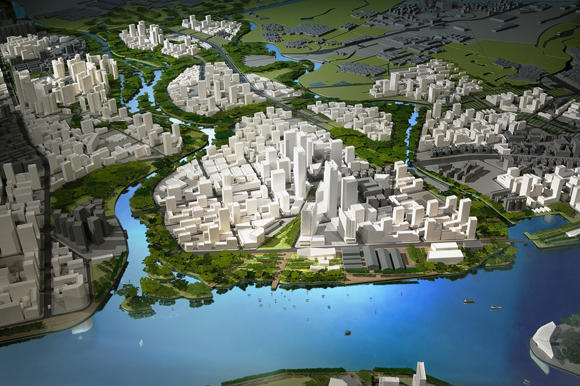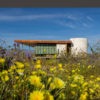
Bry Sarté is principal of Sherwood Design Engineers in San Francisco.
What is the current state of sustainable practice in civil engineering?
Sustainable infrastructure is still evolving, both as a definition and a practice. At this point, nearly every civil engineering firm has a sustainability menu among its offerings, but, I would argue, these offerings are often not integrated with the overall practice.
Storm water management and water resources are among the most forward thinking areas of civil engineering—states and municipalities are beginning to make changes in this regard, with some states now requiring rainwater harvesting. There is also tremendous will to change the energy system with smart grids, wind farms, biofuels, and pilot projects for other innovative advances. But change needs to happen first at the regulatory and code level. Without new codes in place, many sustainable systems cannot easily become widespread.
How have you been involved in this process?
By tackling the regulatory hurdles head on. One of our clients, a retreat center, was recently interested in closing the water loop on its property. Their water rights had been challenged by the state, and their building permits were stalled until they could resolve the issue. They were considering drilling seven, 5500-foot deep wells to tap the aquifer, but we were able to demonstrate—both to the client and to the state—that, through a combination of new technologies, incorporating rainwater harvesting and graywater recycling, we could get to a net-zero, balanced water condition. This immediately released the project to move forward with construction and elevated the regulatory support for our overall efforts.
Following from that success, we organized a symposium with representatives from several counties—designers and developers—to think about how to deal with innovative water systems and the related code hurdles. Out of that symposium came a working group focused on state issues that has been active for the past eighteen months.
What is the largest scale at which you’ve worked?
Our work oscillates between the city, neighborhood, and building scale. We are currently involved with a massive brownfield redevelopment project with SOM San Francisco and Hargreaves Associates in China, with a projected population of 800,000. The site is at the intersection of two megacities that have just physically merged—Guangzhou and Foshan. They are moving heavy industry out, service industry in. We’re helping to develop respiratory and ecological open space to resuscitate this part of the city, comprising 36 square kilometers, redeveloped with 50% open space.
What do you mean by “respiratory open space”?
We’ve been thinking about these spaces as the green lungs of the city. Working there for the past year, we’ve never seen a blue sky in Guangzhou; every hotel room has two oxygen masks. Yet, what’s amazing, for all the China-bashing in the US for their apparent lack of regard for the environment, culturally there’s a deeper appreciation for ecological issues and a stronger emotional investment in ecological systems than in the West. It’s something I’ve observed with everyone we’ve talked to there. Wetland parks are one of the prime attractions in southern China, where people go to look at herons and reeds and walk on the boardwalks. I believe we’re going to see those values reapplied in a much more genuine way than we see here in the US and in Europe. “Integration” is an overarching driver in Guangzhou today—with ecosystems, waterways, air quality. As much as they look to us for expertise today, we’ll be looking to them for models, ten and fifty years from now, as these integrated systems bring their cities into balance.
In San Francisco, we are working on a number of facets of a citywide management plan—taking a watershed approach to storm water management. The challenge we have is that eight to ten times a year, the combined storm water/wastewater system overwhelms the city’s infrastructure and sends untreated sewage into the Bay, occasionally flooding low-lying, poor, minority areas along the way. One potential response that’s been considered for decades by the PUC (San Francisco Public Utilities Commission) is to drill a tunnel across San Francisco, to put all that excess water directly into the ocean—potentially a $1 billion construction project. The community has pressured the PUC for years to consider, instead, an integrated approach. Water runs off the city so fast, and it gets to the edges and has no place to go. So, we are advancing and building a number of projects trying to slow down the water higher up in the watershed. Think of a project like the California Academy of Sciences, which captures 90-98% of the rain that falls on its roof—an estimated 2 million gallons a year. But for us to comprehensively embrace such solutions at an agency level and to implement them in a highly integrated way is challenging. It’s hard to look a hundred years forward in our society.
How does the civil engineering industry handle the change from huge networks of pipes to scattered elements like pervious pavement?
This is the core of many of our designs: balancing between centralized and decentralized infrastructure. There can be great benefits to each. Often the best solution is not one or the other, but a combination. And, in many instances, the centralized infrastructure is already in place and provides a lot of value, since the investment has been paid for.
What are some examples of effective decentralized infrastructure?
In the project in China I mentioned earlier, we discovered that, by instituting simple efficiency measures into individual buildings in our project area, the city could forego construction of a 500-megawatt power plant, which would have cost between $100 million and $600 million, depending on whether it was conventional or nuclear. This is a tremendous cost savings, which means the city can decrease developer fees or provide other incentives. Conceiving infrastructure as a series of smaller, energy efficient projects allows you to look at the overall system.
Take, for example, the Pearl River Tower, by SOM, with mechanical systems designed by Roger Frechette, their Director of MEP and Sustainable Engineering. Ghangzhou has subsidized its construction to help encourage developers to think of buildings as energy generators. Because it’s a highly efficient building, mechanical floors are more efficient, and the void spaces in them are now being dedicated to turbines. The wind accelerates through openings in the building and turns these vertical turbines. The system decreases wind shear on the building while generating power. If you combine that with the high performance building skin, radiant cooling system, and other innovations, the building is driving towards net-zero energy, while it simultaneously becomes a part of the city’s generating system. Planning for hundreds of high-performance buildings in the city district over the next few decades will allow them to avoid building another power plant. So, the buildings are a part of the city’s infrastructure.
The same analogy applies to storm water management. You have a network of pipes in place; they typically lead to end-of-pipe treatment facilities. These systems, especially when combined with wastewater systems, require considerable energy and resources to move and treat the water. Over time, through watershed planning, we can distribute water treatment into the landscape—minimizing the use of water treatment facilities—and use systems funding for multiple benefit solutions that include cleaning water and landscaping the city. As we get those sorts of requirements in place, we are effectively changing all the branches of the collection network. Each building’s selection of a tree or shrub or landscape strip is becoming a part of the city’s infrastructure.
One might suppose that denser development and smaller-scale, distributed infrastructure would be less costly for developers. Is that in fact the case?
Often large-scale infrastructure cost is externalized through bond funding or other public monies. When we make the case for distributed infrastructure, we must develop the argument in the context of first costs, operations, and externalities. Externalities, such as sunken costs in decentralized infrastructure, have a role to play, as do greenhouse gas emissions and other variables. We have the tools to make that argument.

And there are regulatory tools, as well. In the Central Valley, Attorney General Jerry Brown is working with municipalities to put responsible growth plans in place to minimize development of agricultural lands and growth without concern for greenhouse gas emissions. In a recent project example, a large developer in California had proposed a conventional development on a large parcel of rural land. The combination of the state’s pressure and a Sierra Club lawsuit requires them to adopt sustainable design principles in a comprehensive way and to look at the implications of this development as it relates to California’s growth plans. As a result, we’ve been working on a master plan to integrate transit and maximize open space, to close the water loop, and to find ways to move toward net zero carbon at a scale that’s replicable for other developers. If it’s successful as a model, maybe there is some hope for the future of development in California’s Central Valley.

What counsel would you give to architects who want to be more fully engaged in infrastructural issues?
There’s a tremendous opportunity to think about how systems are integrated into the planning process and new construction. Think about allocating space for natural processes to be introduced. Look for overlapping functions, the integration of open space and performative systems. Identify ways to create closed (or nearly closed) loop systems.
Trying to balance water flows into and out of a site is a significant sustainable design objective; tying that principle to specific building scale interventions and technologies opens the possibilities for new design ideas. Thinking about the role of the building as a part of the infrastructure can inspire new directions in architecture; at the most conceptual level, looking for cues in the infrastructure and the form that infrastructure would like to follow can optimize the building design or master plan. Building forms that respond to those decisions can optimize the efficiency of integrated infrastructure. Establishing or reestablishing site systems that respond to nature, perhaps following a dendritic form—like the pattern of a tree’s root system—can complement urban form. Integration of infrastructure can be a springboard for design.
Finally, what advice can you give an architect in selecting a civil engineer who’s clued in to sustainability?
Look for openness to new ideas, especially potential synergies between infrastructure and building systems, and look for experience implementing those ideas. Additionally, see if you can find a willingness to investigate alternative funding sources and to research new ideas that might fit the site. A good civil engineer can show leadership in connecting the dots on the funding side and mustering agency support, rather than running up against agency barriers.
Originally published 4th quarter 2009 in arcCA 09.4, “Infrastructure.”





